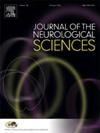Genetic and clinical profile of a Brazilian cohort of dopa-responsive dystonia
IF 3.2
3区 医学
Q1 CLINICAL NEUROLOGY
引用次数: 0
Abstract
Background
Dopa-responsive dystonia (DRD) is a rare genetic and neurotransmitter disorder also known as Segawa Disease. The guanosine triphosphate cyclohydrolase 1 (GCH1) gene variants, inherited in an autosomal dominant pattern, are the most common cause of DRD.
Objectives
To describe the genetic and clinical profile of a Brazilian cohort of DRD patients.
Methods
Twenty-two patients were recruited from the SARAH Network of Rehabilitation Hospitals. A retrospective analysis of phenotype-genotype correlation from the next generation sequencing (NGS) genetic test alongside clinical features and evolution were performed. Clinical measures included: age at the disease onset, gender, time of diagnosis, response to Levodopa medication, behavioral symptoms related to psychiatric disorders.
Results
Variants in genes associated with DRD were detected in 17 patients (77 %), of which 16 (94 %) presented variants in the GCH1 gene (pathogenic variants, n = 10; likely pathogenic variants, n = 6) and, 1 (5 %) in the tyrosine hydroxylase (TH) gene. The average age at disease onset was 7.8 years, with a predominant diagnosis in females, accompanied by a significant delay. A moderate positive response to a low dosage of Levodopa was observed. Patients also reported severe behavioral symptoms related to psychiatric disorders and use of medication.
Conclusions
The autosomal dominant DYT/PARK-GCH1 was the most prevalent subtype. Not all patients were characterized with typical phenotypes contributing to the significant diagnosis delay. Uncommon occurrences of behavioral symptoms and Levodopa-induced dyskinesias were also found. Particular attention is suggested to the autosomal recessive form of the GCH1.
巴西多巴反应性肌张力障碍队列的遗传和临床概况
多巴反应性肌张力障碍(DRD)是一种罕见的遗传性和神经递质疾病,也被称为Segawa病。鸟苷三磷酸环水解酶1 (GCH1)基因变异以常染色体显性模式遗传,是DRD最常见的原因。目的描述巴西一组DRD患者的遗传和临床特征。方法从SARAH康复医院网络中招募22例患者。回顾性分析了来自下一代测序(NGS)基因检测的表型-基因型相关性以及临床特征和进化。临床测量包括:发病年龄、性别、诊断时间、对左旋多巴药物的反应、与精神障碍相关的行为症状。结果17例(77%)患者检测到DRD相关基因变异,其中16例(94%)为GCH1基因变异(致病性变异,n = 10;可能致病性变异,n = 6), 1例(5%)为酪氨酸羟化酶(TH)基因变异。发病的平均年龄为7.8岁,主要诊断为女性,伴有明显的延迟。观察到对低剂量左旋多巴有中度阳性反应。患者还报告了与精神障碍和药物使用有关的严重行为症状。结论常染色体显性DYT/PARK-GCH1是最常见的亚型。并非所有患者都具有典型的表型,这导致了显著的诊断延迟。少见的行为症状和左旋多巴引起的运动障碍也被发现。建议特别注意常染色体隐性形式的GCH1。
本文章由计算机程序翻译,如有差异,请以英文原文为准。
求助全文
约1分钟内获得全文
求助全文
来源期刊

Journal of the Neurological Sciences
医学-临床神经学
CiteScore
7.60
自引率
2.30%
发文量
313
审稿时长
22 days
期刊介绍:
The Journal of the Neurological Sciences provides a medium for the prompt publication of original articles in neurology and neuroscience from around the world. JNS places special emphasis on articles that: 1) provide guidance to clinicians around the world (Best Practices, Global Neurology); 2) report cutting-edge science related to neurology (Basic and Translational Sciences); 3) educate readers about relevant and practical clinical outcomes in neurology (Outcomes Research); and 4) summarize or editorialize the current state of the literature (Reviews, Commentaries, and Editorials).
JNS accepts most types of manuscripts for consideration including original research papers, short communications, reviews, book reviews, letters to the Editor, opinions and editorials. Topics considered will be from neurology-related fields that are of interest to practicing physicians around the world. Examples include neuromuscular diseases, demyelination, atrophies, dementia, neoplasms, infections, epilepsies, disturbances of consciousness, stroke and cerebral circulation, growth and development, plasticity and intermediary metabolism.
 求助内容:
求助内容: 应助结果提醒方式:
应助结果提醒方式:


